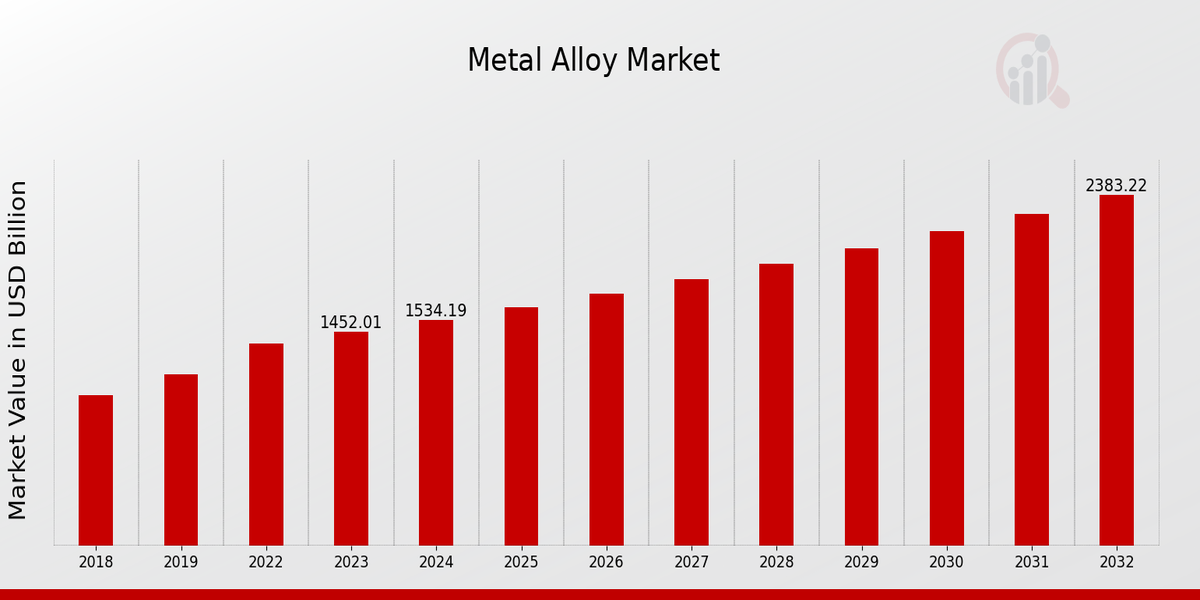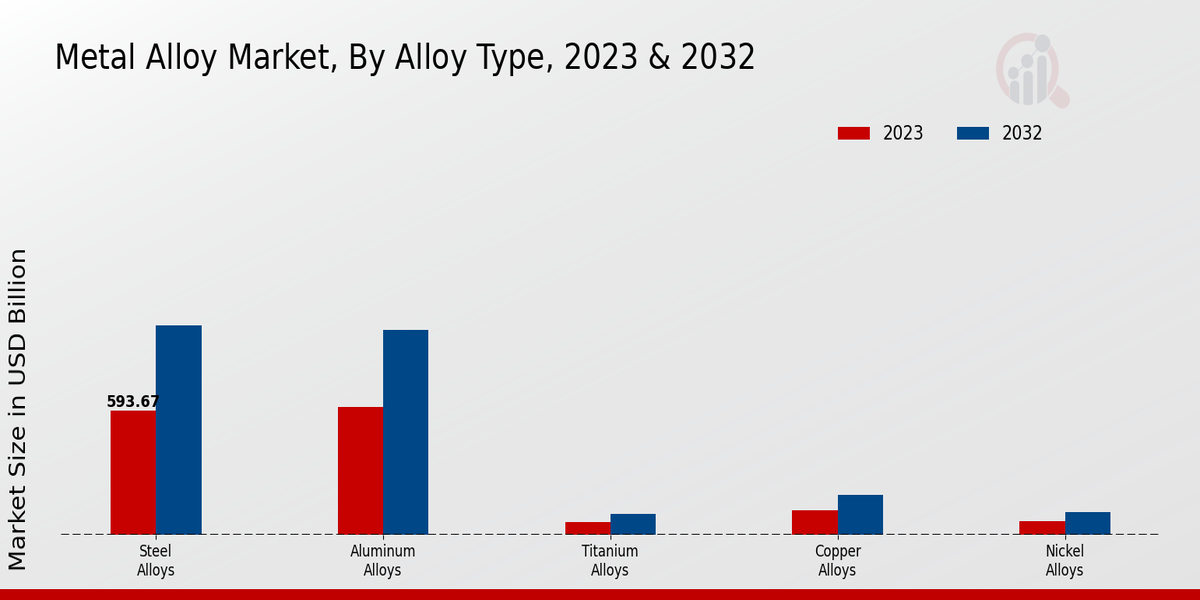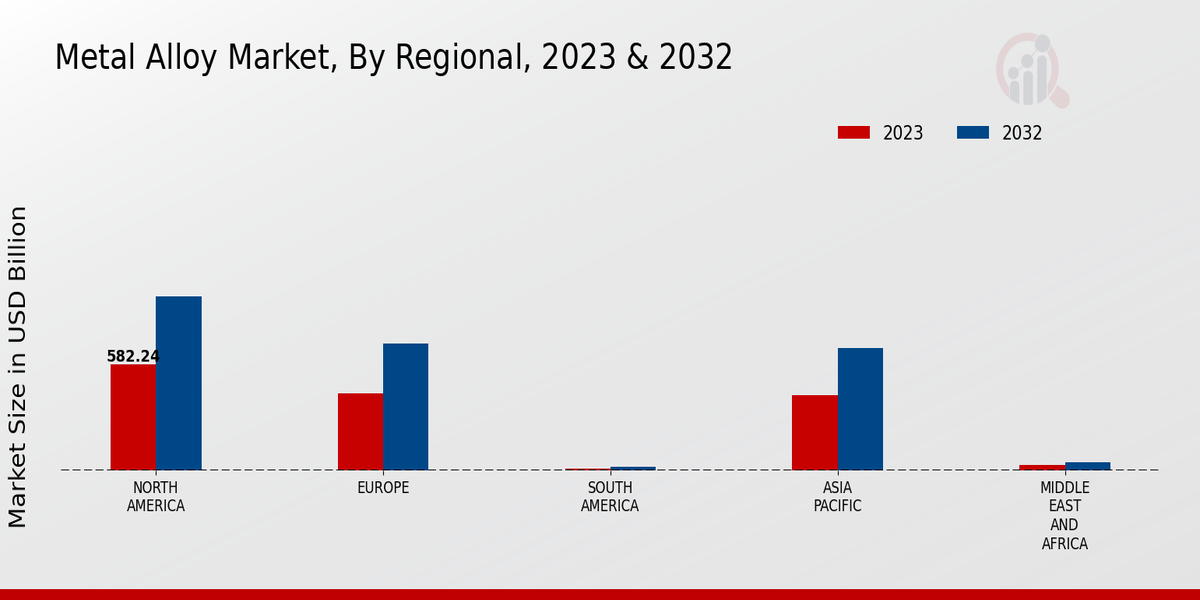Global Metal Alloy Market Overview
The Metal Alloy Market Size was estimated at 1,621.11 (USD Billion) in 2024.The Metal Alloy Market Industry is expected to grow from 1,712.90 (USD Billion) in 2025 to 2,811.92 (USD Billion) by 2034. The Metal Alloy Market CAGR (growth rate) is expected to be around 5.7% during the forecast period (2025 - 2034).
Key Metal Alloy Market Trends Highlighted
The increasing demand for lightweight and high-strength materials in industries such as automotive, aerospace, and construction is a key driver in the metal alloy market. The growing adoption of metal alloys in the manufacturing of electric vehicles and lightweight components for fuel efficiency also presents significant opportunities. Advanced manufacturing techniques, such as additive manufacturing and powder metallurgy, are enabling the development of new and innovative metal alloys, further driving market growth. Additionally, the shift towards sustainability and the need for materials with enhanced corrosion resistance and durability are creating opportunities in the metal alloy market.

Source: Primary Research, Secondary Research, MRFR Database and Analyst Review
Metal Alloy Market Drivers
Rising Demand for Lightweight and Durable Materials in Automotive and Aerospace Industries
The automotive and aerospace industries are major consumers of metal alloys, driven by the need for lightweight and durable materials. In the automotive industry, metal alloys are used in various components, such as engine blocks, transmission housings, and suspension systems, to reduce weight and improve fuel efficiency. Similarly, in the aerospace industry, metal alloys are used in aircraft structures, engines, and landing gear to achieve high strength-to-weight ratios and withstand extreme operating conditions.The growing demand for lightweight and fuel-efficient vehicles, along with the increasing production of aircraft, is expected to drive the growth of the metal alloy market in these industries.
Expansion of Construction and Infrastructure Sectors in Developing Economies
Construction and infrastructure sectors in developing economies are rapidly growing on the back of ever-increasing urbanization and government spending. Metal alloys are notably used in numerous building and construction projects, including bridges, buildings, and roads; and are worthwhile due to their strength, life span, and resistance to corrosion. Therefore, expansion of infrastructure in emerging markets may foster the growth of the metal alloy market.
Advancements in Metal Alloy Manufacturing Technologies
Technology advancements in the metal alloy manufacturing process are paving the way for the development of new alloys with better properties and reduced production costs. The advanced technologies applied in the manufacturing process are advanced casting technologies, powder metallurgy, and additive manufacturing, which produce the metal alloy with complex shape, high strength, and better corrosion resistance. The superior alloy developed with these advanced technologies will help companies enhance the competitiveness of metal alloy manufacturers and drive the growth of the Metal Alloy Market Industry.
Metal Alloy Market Segment Insights
Metal Alloy Market Alloy Type Insights
The Metal Alloy Market is segmented into five major Alloy Type segments: Steel Alloys, Aluminum Alloys, Titanium Alloys, Copper Alloys, and Nickel Alloys. The Steel Alloys segment has led the overall market. The segment accounted for around 55.0% of the Metal Alloy Market in 2023, with a market value of $798.6 Billion. The Aluminum alloy segment is expected to be the fastest-growing market, with a CAGR of 6.18%, throughout the forecast period. This is mainly due to the continuous demand from the automotive and aerospace industries.Steel Alloys are one of the most widely used alloys across the world. It is used in the construction, automotive, and manufacturing industries, among others. The alloys are highly durable, strong, and corrosion-resistant alongside high strength. Aluminum Alloys are lightweight with an excellent strength-to-weight ratio and are, hence, preferred in the aerospace, automotive, and consumer electronics industries. The high-strength-to-weight ratio provides wind resistance to the automotive bodies and reduces fuel consumption. The metal is recyclable and hence is environmentally friendly.Titanium Alloys, on the other hand, are renowned for their high strength alongside low density and corrosion resistance. The alloys are used in the aerospace, medical, and chemical processing industries, among others. Similarly, Copper Alloys offer high electrical conductivity and are used in electrical and electronic applications. Synthetic materials, like silver and gold, are used to increase the strength, color or appearance. Finally, Nickel Alloys are known for their strength, corrosion resistance, and heat resistance. The alloys are used in the aerospace, chemical processing, and marine industries, among others.The growth can be mainly attributed to the increased demand for automotive, aerospace, construction, and other end-use industries. All over the world, lightweight, high strength and increased demand from such industries are expected to drive the growth of the market.

Source: Primary Research, Secondary Research, MRFR Database and Analyst Review
Metal Alloy Market Application Insights
The Metal Alloy Market is segmented into various applications, including Aerospace, Automotive, Construction, Oil and Gas, and Medical. Each application segment has its unique set of requirements and growth drivers. The Aerospace segment of the Metal Alloy Market is expected to witness significant growth in the coming years, driven by the increasing demand for lightweight and high-strength materials in aircraft manufacturing. The Automotive segment is also expected to grow steadily as metal alloys are increasingly used in vehicle components to improve durability and fuel efficiency.The Construction segment is another major application area for Metal Alloys, as they are used in a wide range of structural components, such as beams, columns, and reinforcements. The growth of the market is attributed to the increasing demand for metal alloys in various industries, such as aerospace, automotive, construction, oil and gas, and medical.
Metal Alloy Market Product Form Insights
The Metal Alloy Market is segmented by Product Form into Ingots, Billets, Sheets, Tubes, and Powders. Among these, the Ingots segment held the largest market share in 2023 and is expected to continue its dominance throughout the forecast period. The growth of this segment can be attributed to the increasing demand for ingots in various industries, including automotive, construction, and aerospace. The Billets segment is also expected to witness significant growth, driven by the rising demand for billets in the construction industry. The Sheets segment is anticipated to grow steadily, owing to the increasing use of sheets in the manufacturing of automotive components and appliances.The Tubes segment is expected to exhibit moderate growth, supported by the rising demand for tubes in the energy and construction industries. The Powders segment is projected to experience the highest growth rate during the forecast period due to the growing demand for powders in the production of advanced materials and coatings.
Metal Alloy Market Grade Insights
The Metal Alloy Market is segmented by Grade into Low-Alloy, Medium-Alloy, High-Alloy, and Superalloy. Among these, the High-Alloy segment is expected to hold the largest market share in 2023, owing to its superior strength, hardness, and corrosion resistance properties. The segment is projected to retain its dominance throughout the forecast period, driven by its increasing adoption in various industries, including automotive, aerospace, and construction. The Low-Alloy segment is also expected to witness significant growth, primarily due to its cost-effectiveness and wide range of applications in industries such as automotive, construction, and manufacturing.
Metal Alloy Market Market Verticals Insights
The Metal Alloy Market is segmented into several market verticals, including OEMs, Tier 1 Suppliers, Distributors, and End-Users. OEMs, or Original Equipment Manufacturers, account for a significant portion of the Metal Alloy Market revenue, driven by the demand for metal alloys in the automotive and aerospace industries. Tier 1 Suppliers play a crucial role in the supply chain, providing raw materials and components to OEMs. Distributors facilitate the distribution of metal alloys to various end-users, such as manufacturers and construction companies.End-Users represent the final consumers of metal alloys and include industries such as automotive, aerospace, construction, and electronics. The Metal Alloy Market is experiencing steady growth, driven by increasing demand from various industries. The growing adoption of lightweight and durable metal alloys in industries such as automotive and aerospace is a key factor contributing to market growth.
Metal Alloy Market Regional Insights
The Metal Alloy Market is segmented by region into North America, Europe, APAC, South America, and MEA. The APAC region is expected to hold the largest market share in 2023, owing to the increasing demand for metal alloys in the automotive and construction industries. The North American region is expected to witness significant growth in the metal alloy market due to the rising demand for lightweight materials in the aerospace and defense industries. The European region is expected to have a steady growth rate in the metal alloy market due to the increasing demand for metal alloys in the manufacturing and transportation industries.The South American and MEA regions are expected to witness moderate growth in the metal alloy market due to the increasing demand for metal alloys in the infrastructure and energy industries.

Source: Primary Research, Secondary Research, MRFR Database and Analyst Review
Metal Alloy Market Key Players And Competitive Insights:
Major players in Metal Alloy Market are constantly engaged in research and development activities to enhance their product offerings and stay competitive. Leading Metal Alloy Market players adopt various strategies, such as mergers, acquisitions, and partnerships, to strengthen their market position. For instance, in 2021, Materion Corporation acquired H.C. Starck Tungsten Powders, a leading supplier of tungsten powders. This acquisition expanded Materion's product portfolio and strengthened its position in the metal alloy market. The Metal Alloy Market industry is characterized by a high level of competition, with numerous established and emerging players vying for market share.A leading company in the Metal Alloy Market is Materion Corporation. Headquartered in the United States, Materion is a manufacturer of high-performance materials, including metal alloys. The company offers a wide range of metal alloys, including titanium, zirconium, and beryllium, which are used in various industries, including aerospace, medical, and electronics. Materion has a strong focus on research and development, and it continuously invests in new technologies and products. The company has a presence, with manufacturing facilities in North America, Europe, and Asia.A competitor company in the Metal Alloy Market is ATI (Allegheny Technologies Incorporated). Headquartered in the United States, ATI is a manufacturer of specialty materials, including metal alloys. The company offers a wide range of metal alloys, including stainless steel, nickel-based alloys, and titanium alloys, which are used in various industries, including aerospace, energy, and automotive. ATI has a strong focus on quality and innovation, and it continuously invests in new technologies and products. The company has a presence, with manufacturing facilities in North America, Europe, and Asia.
Key Companies in the Metal Alloy Market Include:
- MetalTek International
- ATI
- Eramet
- Outokumpu Oyj
- Bohai Steel Group Co., Ltd.
- Aperam
- Sandvik AB
- Aperam Alloys Imphy
- Haynes International
- JFE Steel
- Allegheny Technologies Incorporated
- Valbruna S.p.A.
- Kobe Steel, Ltd.
- Carpenter Technology Corporation
- POSCO
Metal Alloy Market Industry DevelopmentsThe metal alloy market is expected to experience significant growth in the coming years. This growth is being driven by the increasing demand for metal alloys in various industries, including aerospace, automotive, and construction.One of the major trends in the metal alloy market is the development of new and innovative alloys. These alloys are designed to meet the specific requirements of different industries. For example, the aerospace industry is demanding alloys that are lightweight, strong, and resistant to corrosion. The automotive industry is looking for alloys that are lightweight and fuel-efficient. The construction industry is seeking alloys that are strong, durable, and resistant to wear and tear.Another major trend in the metal alloy market is the increasing use of metal alloys in additive manufacturing. Additive manufacturing, also known as 3D printing, is a process that allows manufacturers to create complex metal parts from a digital file. This process is becoming increasingly popular in the aerospace, automotive, and medical industries.Overall, the metal alloy market is expected to continue to grow in the coming years. This growth will be driven by the increasing demand for metal alloys in various industries, the development of new and innovative alloys, and the increasing use of metal alloys in additive manufacturing.
Metal Alloy Market Segmentation Insights
Metal Alloy Market Alloy Type Outlook
- Steel Alloys
- Aluminum Alloys
- Titanium Alloys
- Copper Alloys
- Nickel Alloys
Metal Alloy Market Application Outlook
- Aerospace
- Automotive
- Construction
- Oil and Gas
- Medical
Metal Alloy Market Product Form Outlook
- Ingots
- Billets
- Sheets
- Tubes
- Powders
Metal Alloy Market Grade Outlook
- Low-Alloy
- Medium-Alloy
- High-Alloy
- Superalloy
Metal Alloy Market Market Verticals Outlook
- OEMs
- Tier 1 Suppliers
- Distributors
- End-Users
Metal Alloy Market Regional Outlook
- North America
- Europe
- South America
- Asia Pacific
- Middle East and Africa
Metal Alloy Market Report Scope
| Report Attribute/Metric |
Details |
| Market Size 2024 |
1,621.11 (USD Billion) |
| Market Size 2025 |
1,712.90 (USD Billion) |
| Market Size 2034 |
2,811.92 (USD Billion) |
| Compound Annual Growth Rate (CAGR) |
5.7% (2025 - 2034) |
| Report Coverage |
Revenue Forecast, Competitive Landscape, Growth Factors, and Trends |
| Base Year |
2024 |
| Market Forecast Period |
2025 - 2034 |
| Historical Data |
2020 - 2024 |
| Market Forecast Units |
USD Billion |
| Key Companies Profiled |
MetalTek International, ATI, Eramet, Outokumpu Oyj, Bohai Steel Group Co., Ltd., Aperam, Sandvik AB, Aperam Alloys Imphy, Haynes International, JFE Steel, Allegheny Technologies Incorporated, Valbruna S.p.A., Kobe Steel, Ltd., Carpenter Technology Corporation, POSCO |
| Segments Covered |
Alloy Type, Application, Product Form, Grade, Market Verticals, Regional |
| Key Market Opportunities |
Growth in Aerospace Industry Increasing Demand for Electric Vehicles Rising Infrastructure Spending Demand for Lightweight Alloys Technological Advancements |
| Key Market Dynamics |
Alloy diversification increasing demand technological advancements, government regulations, supply chain disruptions |
| Countries Covered |
North America, Europe, APAC, South America, MEA |
Frequently Asked Questions (FAQ) :
The Metal Alloy Market is expected to reach a valuation of 1,712.90 billion USD in 2025, showcasing a promising growth trajectory.
The Metal Alloy Market is anticipated to expand at a steady CAGR of 5.7% during the forecast period from 2025 to 2034.
The Asia-Pacific region is projected to lead the Metal Alloy Market throughout the forecast period, primarily driven by the burgeoning automotive and construction industries in countries like China and India.
Metal alloys find extensive applications across various industries, including aerospace, automotive, construction, electrical, and consumer electronics, owing to their exceptional properties such as strength, durability, and corrosion resistance.
Prominent players in the Metal Alloy Market include ArcelorMittal, Baosteel Group, Nippon Steel Corporation, Posco, and Tata Steel, among others.
The increasing demand for lightweight and high-performance materials in industries such as automotive and aerospace is a significant growth driver for the Metal Alloy Market.
The Metal Alloy Market faces challenges related to raw material price fluctuations and intense competition from alternative materials such as composites and plastics.
The Metal Alloy Market is projected to reach a substantial valuation of 2,811.92 billion USD by 2034, reflecting a significant increase in market size over the forecast period.
The automotive segment is anticipated to exhibit the highest CAGR during the forecast period, driven by the rising demand for lightweight and fuel-efficient vehicles.
The Metal Alloy Market is witnessing the adoption of advanced manufacturing technologies such as additive manufacturing and the integration of artificial intelligence (AI) for process optimization and quality control.

















